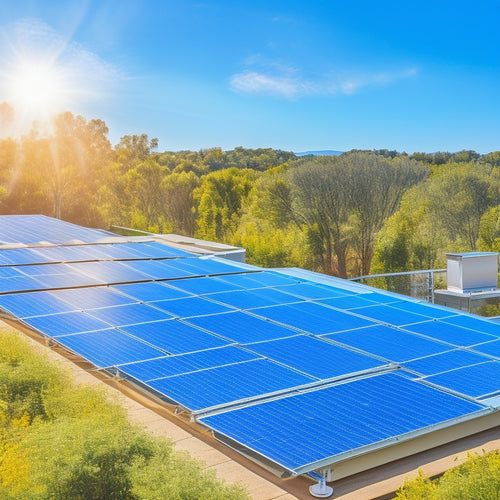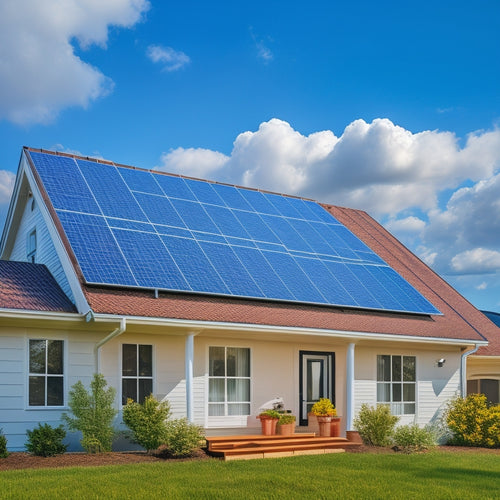
5 Best Solar Energy Independence Secrets
Share
You're on the verge of tapping into free renewable energy, cutting ties with utility companies, and taking control of your power destiny. By strategically designing solar panel installations, maximizing energy production, and utilizing energy storage solutions, you can reduce your reliance on the grid and achieve long-term savings. To further optimize your solar performance, focus on regular cleaning, real-time monitoring, and proper panel placement. Furthermore, you'll shield yourself from rate hikes by storing excess energy and investing in reliable energy storage solutions. Now, you're ready to reveal the secrets of solar energy independence and enable your off-grid living.
Overview
- Strategic design of solar panel installations ensures energy independence by meeting specific energy needs and reducing reliance on the grid.
- High-efficiency solar panels and energy storage solutions like batteries maximize energy production and utilization, minimizing utility dependence.
- Regular maintenance, including cleaning and inspecting, optimizes solar panel performance, guaranteeing consistent energy output and independence.
- Investing in reliable energy storage solutions, like batteries, enables homeowners to store excess energy for peak hours or nighttime use, breaking free from utility rate hikes.
- Proper panel placement, angle, and orientation ensure optimal sunlight capture, further enhancing energy independence and reducing carbon footprint.
Unlocking Free Renewable Energy
As you investigate the world of solar energy, you're likely driven by a desire to reveal the secrets of free renewable energy. You're on a mission to utilize the power of the sun to fuel your daily life, and you're not alone.
Governments and companies are investing heavily in solar panel innovations, driving down costs and increasing efficiency. In fact, the decreasing costs of solar energy make it competitive with fossil fuels in many regions, contributing to enhanced sustainability and a reduced carbon footprint sustainable energy solutions.
Renewable energy incentives, such as tax credits and rebates, are also making it more accessible than ever, with federal tax credits and state rebates greatly lowering upfront costs for solar installations.
Cutting Ties With Utility Companies
You've made considerable progress in utilizing free renewable energy, and now it's time to take the next logical step: cutting ties with utility companies.
This involves strategically designing your solar panel installation to meet your energy needs, ensuring you produce enough power to sustain your lifestyle. By choosing the right solar panels high-efficiency panels, you can maximize your energy production while minimizing installation costs.
With energy storage solutions, like batteries, you can store excess energy generated during the day for use during the night or on cloudy days. By doing so, you'll greatly reduce your reliance on the grid, giving you more control over your energy usage and costs.
As you sever ties with utility companies, you'll enjoy greater energy independence, reducing your carbon footprint and saving money in the long run.
Maximizing Energy Self-Sufficiency
Your solar panel system is now producing a substantial amount of energy, and it's time to optimize its performance to maximize energy self-sufficiency.
To do this, you'll want to focus on improving solar panel efficiency, which can be achieved through regular cleaning, as real-time monitoring of energy production helps identify areas for improvement.
Additionally, proper placement of panels to minimize shading from trees and structures is essential. This can be achieved by ensuring your panels are clean and free of debris, as well as adjusting their angle and orientation to capture the most sunlight.
Additionally, consider investing in energy storage solutions like batteries to store excess energy generated during the day for use at night or during power outages.
Shielding Against Rate Hikes
How vulnerable are you to rate hikes imposed by your utility company? With solar energy independence, you can shield yourself from these unpredictable increases.
By investing in high-efficiency solar panels, you'll maximize your energy production and reduce your reliance on the grid. However, to truly break free from rate hikes, you need a reliable energy storage solution.
This allows you to store excess energy generated during the day for use during peak hours or at night, reducing your dependence on the utility company.
Empowering Off-Grid Living
Most homeowners who opt for solar energy independence have a common goal: to live off-grid, free from the constraints of traditional utility companies.
You're seeking autonomy and self-sufficiency, where you control your energy destiny. To achieve this, you'll need to prioritize solar panel maintenance to guarantee peak energy production.
Regular cleaning, inspecting, and repairing your system will maximize its output. Additionally, investing in energy storage solutions, such as batteries, will allow you to utilize excess energy generated during the day for night-time use or during grid outages.
Frequently Asked Questions
How Do I Determine the Best Solar Panel Angle for My Location?
To determine the best solar panel angle for your location, you'll need to take into account your latitude and local climate. Aim for an ideal tilt between 30-40 degrees, adjusting for seasonal variations to maximize energy harvest and achieve solar independence.
Can I Use Solar Energy to Power My Electric Vehicle?
Did you know 80% of EV owners also own a solar panel system? You can join them! Yes, you can use solar energy to power your electric vehicle through solar charging, reducing your carbon footprint and energy dependence.
Are There Any Solar Energy Storage Options Besides Batteries?
You're exploring alternative solar energy storage options beyond batteries; consider thermal storage, where excess energy heats or cools materials for later use, or pumped hydro systems, which store energy by pumping water between reservoirs, offering reliable backup power.
How Often Should I Clean My Solar Panels for Optimal Performance?
You'll be shocked to know that dirty solar panels can lose up to 25% of their efficiency! To avoid this, you should clean your solar panels every 6-12 months as part of regular solar panel maintenance, ensuring peak performance and energy independence.
Are Solar Panels Resistant to Extreme Weather Conditions Like Hail?
You'll be relieved to know that most solar panels are designed to withstand extreme weather conditions, including hail damage, thanks to their weather durability features, such as tempered glass and sturdy frames, ensuring your energy independence remains uninterrupted.
Ready to Buy
You've now revealed the secrets to solar energy independence, and it's time to reap the benefits. Remember, "an ounce of prevention is worth a pound of cure" - investing in renewable energy today will save you from the weight of rising utility costs tomorrow. By implementing these strategies, you'll not only cut ties with utility companies but also maximize your energy self-sufficiency, shield yourself against rate hikes, and enable off-grid living. Take control of your energy future now and start utilizing the power of the sun.
Related Posts
-

What Types of Solar Energy Devices Are Available
You'll find several types of solar energy devices available today, each customized to different energy needs. Photovo...
-

Top Portable Refrigerators for Camping Adventures
When you're camping, having a reliable portable refrigerator can make all the difference for keeping your food fresh ...
-

Cost of Solar Panel Installation
You can expect to pay between $15,000 and $30,000 or more for a typical solar panel installation, depending on the sy...


